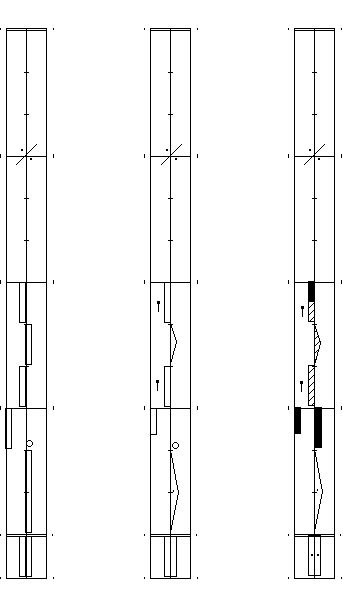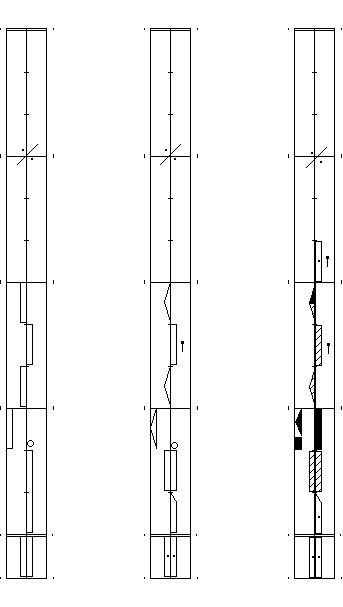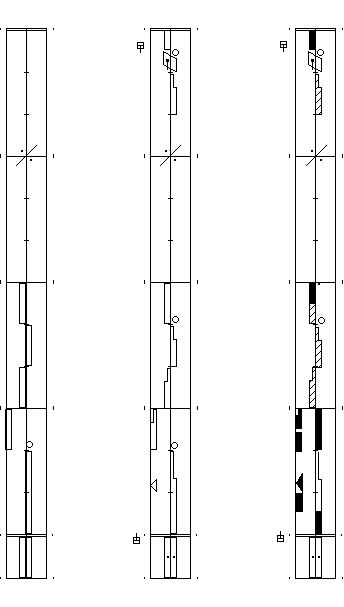RUDOLF LABAN’S MINUET IN CHOREGRAPHIE (1926)
Jeffrey Scott Longstaff
Andrea Treu
Darren Royston
Abstract
Rudolf Laban included a chapter on the minuet in "Choreographie" (1926) but offered little explanation. Interviewing his students, reviewing notations, and considering his methodology of deriving theoretical concepts through analysis of basic patterns in traditional movement forms, indicated how the minuet influenced theories of spatial harmony or ‘Choreutics’ and also notation methods in Labanotation / Kinetography. In dance history classes the minuet’s spatial refinement was considered where the minuet steps right, left, forward (passing), and balance were taken as examples of cardinal planes sometimes called ‘door’, ‘wheel’ and ‘table’. The workshop approaches minuet steps through Labanotations in varying degrees of detail.
Introduction
This research began with a question: In Rudolf Laban’s 1926 German book Choreographie, an entire chapter is devoted to, and titled “the Minuet”. However the chapter only contains a verbal description of the dance, and he did not explain why it was important for him.
This question was considered from several perspectives.
Interviews with Rudolf Laban's students
Laban’s dance history classes were recounted by Valerie Preston-Dunlop, where they practised several dances, including the minuet, as a way to study dance history in actual movement.
Laban frequently used an method of examining traditional dances and movement styles (ie. sabre fighting, ballet, work movements) as part of his process of developing concepts for movement analysis and movement notation.
Considered the minuet as an illustration of refined spatial form and design.
a basic structure of body space, exemplified in the minuet, was identified as the "three planes", which Laban sometimes called “door plane”, “wheel plane”, and “table plane”.
This spatial structure was influenced theories of space harmony in the system of 'choreutics', and also methods for movement notation in Labanotation / Kinetography.
Spatial direction signs (Fig. 1)
For detailed analysis of body-space, Rudolf Laban, together with many co-workers, devised "direction signs" which are used in both Choreutics and Labanotation (Fig. 1).
The direction is indicated by the shape of each sign, which seem to 'point' in a direction with a rectangle sign as center.

|

High level
|
|

Middle level
|
|

Low level
|
Three levels are indicated by the color or shading of each sign, with high, medium, and low levels.
When the three cardinal planes are distinguished, it can be seen that the shape of the signs are different for each of the three cardinal planes, wheel, door, and table.
|

|
|
DOOR PLANE
|
WHEEL PLANE
|
TABLE PLANE
|
|
Figure 2. Three planes with direction signs (Fig. 2)
|
Verbal descriptions of the minuet by Laban and Klemm
The significance of the minuet for Rudolf Laban was also probed by examining his detailed verbal description, comprising an entire chapter in Chreographie (1926) [*].
The account consists solely of a verbal step-by-step description of the body movements of 4 basic minuet steps: 1) minuet step right, 2) minuet step left, 3) minuet forward or 'passing' step, and 4) minuet balance
Also contains an enumeration of a longer series of these steps in a complete dance including bows (144 bars).
In an interview with Roderyk Lange, it was pointed out that Laban's text follows almost exactly an earlier publication by Bernhard Klemm in Handbuch der Tanzkunst. (1910) [*]
Laban re-presented virtually the identical description as in Klemm, making only a few minor changes.
For example relating to his purpose of creating a new modern dance where gender roles are equal:
|
Klemm:
|
der Herr, die Dame
|
|
Laban:
|
Person A, Person B
|
Other than this, Laban's description was virtually identical to Klemm, but in several cases Klemms description is more complete.
Klemm's description was used to compare and clarify Laban's description, who both presented the same details of movement directions and rhythms of the minuet steps.
In some cases Klemm's account was more complete, allowing clarifications of Laban's writing, for example in enumerating the exact duration of counts for each step, and offering drawings of the relative positions of dancers.
Review Labanotations of minuet
To further decipher the use of the minuet by Rudolf Laban, several Labanotation scores of the minuet were examined:
* Bartenieff, I., Jooss, K., Knust, A., & Reber, G. (Labanotation) (1936). Menuett aus dem XIX Jahrhundrert nach dem buch von Bernhard Klemm.
* Danker, Inge. (notator) (1954). Standardform des Menuetts, aus dem Anfang des 18. Jahrhunderts (notation, system Feuillet, und Wortbeschreibung von Kellom Tomlinson in “the Art of Dancing”, 1724, published in London 1735).
* Reber, Gisela. (notator) (1966?). Das Menuett nach Gottfried Taubert’s “Rechtschaffener Tantzmeister” 1717.
* Reber, Gisela, with Eckerle, Christine. (notators) (1986). Die Schrittformen und Armführungen nach Le Maître a Danser 1725 von Pierre Rameau.
|
The Labanotations show a variety of different styles of minuet at at different periods and places.
This is also influenced by how much detail is included by the notator (if leg or arm gestures are included or not)
The notation by Bartenieff and colleagues (1936) explicitly states is relationship with the description of Klemm, and follows the sequence of counts in 144 bars, identically with his description.
Hence, this notation was taken as prime resource for considering the minuet as intended by Laban.
Movement in three cardinal planes
The three cardinal planes are basic structure of body space exemplified in the minuet and which Laban sometimes called “door plane”, “wheel plane”, and “table plane”.
One way to explore the cardinal planes is for everyone to move in the same plane together.
Door plane
* The door plane is flat and wall-like. Sometimes called 'frontal plane' or 'vertical plane'
* Arm, leg, torso movements in the plane are possible.
* Travelling movements possible, but the plane seems better for standing.
* Door planes can be all in the same facing, ... ... or doors can face different directions.
* Particular types of human interactions are afforded when using this plane.
........ it is good for waving 'hi', good for 'confronting' or 'presenting', saying 'stop', good for saying "ME", or "I want this!" (pushing downward), or "I am great!" (pushing upward), it is aligned with gravity, and so is good for 'standing', ............
Table plane
* The table plane is like a flat surface, a table, or floor, or vista, or horizon.
* Arm, leg, torso movements in plane are possible ... ballet ren de jamb
* Travelling movements are possible, in circles, a kind of extension of arm or leg movements
* Particular character of human interaction is afforded when using this plane.
.......... it is good for contacting and enclosing someone, or also for pusing them to the side, it is good for changing and turning to new directions, it is good for exploring out the entire space, also good for 'turning in' exploring a micro-sphere, it is perpendicular to gravity and so is good for working with materials, spreading out objects for manipulation in a work-space ...........
Wheel plane
* The wheel plane is like a narrow passage, allowing only motion forward or back.
* Arm, leg, torso movements are possible, but limited to almost to pure flexion and extension.
* Travelling movements are especially afforded, but mostly in straight lines
* Wheel planes can all travel in the same direction .... or wheel planes could travel in different directions
* Particular character of human interaction is afforded when everyone is moving in this plane
.... ..... ..... can be very organised, can be fast and purposful, can be useful for organised groups of people, but mostly as 'in front, behind' relationship, 'queing', 'following-leading', it is perfect for covering distance, getting from A to B in the shortest distance, ...
it is aligned with gravity but moreover it makes use of anterior and posterior surfaces of the body, designed for locomotion,
Different planes in interaction
* Different planes can be simultaneous in the same body, --- Lower body moving in wheel plane while upper body moves in table plane. ....
* Particular characters of human interaction may also arise with people move in different planes at the same time. ..... Each person pick their favourite plane. -- how do different planes interact?
|
Minuet stepping rhythm (Fig. 3)
Laban and Klemm both described how the minuet can be danced with a variety of different rhythms of steppng.
Examining the variety of Labanotation scores also shows different rhythms of stepping in the different scores.
The score by Bartenieff and colleagues uses a consistent rhythm throughout, and so this is followed here.
This stepping rhythm can be 'read' in the simplified Labanotation motif, showing the timing of weight-shifts from the right to the left.
The basics or reading Labanotation include:
* The staff, showing columns for 'support' and gestures
* tick marks indicating metric counts
* Signs showing that a movement or action happens
* Length of sign indicates duration.
|

|
|

|
The simple Labanotation can be used to 'read' the stepping rhythm together with music.
This same stepping rhythm is used in all four minuet steps, in this version.
|

|
|
BASIC RHYTHM
|
DIRECTIONS
|
LEVELS & GESTURES
|
|
Figure 4..MINUET STEP RIGHT
|
'Door' plane in the minuet step right (Fig. 4)
A slightly more detailed Labanotation can be used to indicate the directions of steps and gestures in the minuet step right.
Pins indicate when a step is placed directly in front or behind the other foot.
In the more detailed Labanotation, it can be seen that the predominant sidewards stepping also includes changes of levels.
The sideways stepping, with accompanying reaching of the leg just before the sideways step, and a brief trailing of the leg just after the step, contributes to an overall presentation of body in the door plane.
'Door' plane in the minuet step left (Fig. 5)
The minuet step left also moves primarily sideways, but is complicated because of the right leg stepping crossways towards the left.
The simple Labanotation shows the direction of stepping where the right leg deviates towards stepping across the body, then being followed by leftward steps by the left.
For a moment, on count 2, the legs are pulled together, as the left leg passes through on its way to a gesture.
The detailed Labanotation shows the rising and lowering of the levels.
Similar to the minuet step right, the step left also emphasises movement to the side, with accompanying reaching of the leg just before the sideways step (count 3), and a brief trailing of the leg just after the step, contributes to an overall presentation of body in the door plane.
|

|
|
BASIC RHYTHM
|
DIRECTIONS
|
LEVELS & GESTURES
|
|
Figure 5..MINUET STEP LEFT
|
|

|
|
BASIC RHYTHM
|
DIRECTIONS
|
LEVELS & GESTURES
|
|
Figure 6..MINUET FORWARD STEP
|
'Wheel' plane in the minuet forward step ('passing step') (Fig. 6)
The simple Labanotation shows the rhythm of the forward stepping. The slow forward step includes a brief leg gesture to the side (count 2), and then reaching forward (count 3) just prior to the following step (count 4).
The detailed Labanotation shows the level of stepping and details of the leg gesture.
The overall progression of the forward step, is exactly as its name, forward, this is especially shown with the well prounounced forward reaching leg gesture. The combination of low and high levels used also emphasise the full range of motion within that plane.
On count 6, the weight is momentarily on both legs, before beginning another step. After travelling forward this moment is often used to turn towards a new direction.
'Table' plane in the minuet balance (Fig. 7)
The basic stepping rhythm in the minuet balance is slightly different than the other minuet steps.
As the name indicates, the step is balanced equally between the right and left.
The Labanotations also show how the arms raise and open during the step.
The simple Labanotation show a step forward while the leg gestures to the side, balanced by the following step back while the other leg gestures sideways.
The detailed Labanotation shows the levels of stepping and details of the gesture.
Overall, the minuet balance gives the impression of the table plane as it opens or spreads outward and sideward. This character of the table plane is reinforced in the full minuet dance when this step is frequently used as a prelude to holding hands and turning with a partner. These are the types of interactions and motions typically associated with this plane.
|

|
|
BASIC RHYTHM
|
DIRECTIONS
|
LEVELS & GESTURES
|
|
Figure 7..MINUET BALANCE
|
It might be noticed that the minuet balance has an almost identical beginning with the minuet forward step. In the sequences described by Klemm and Laban, the balance typically appears just prior to the minuet forward step. Further, the forward step is then used for the circular traveling while partners hold hands. These features seem to indicate, as visited earlier, how the table plane and wheel plane can have potential to interact.
Summary
Rudolf Laban included an entire chapter on the minuet in his early book "Choreographie" (1926) but gave no explanation on its significance.
This question was approached by interviewing Rudolf Laban's students and reviewing notations of the minuet
It was reported that the minuet was taught by Rudolf Laban in his dance history classes and offered as an example of spatial forms and designs.
The basic minuet steps; minuet step right and step left, minuet forward step, and minuet balance step, were taken as examples of three cardinal planes which Laban sometimes called the door plane, the wheel plane, and table plane.
Movement in these three planes gives an impression of their significance for human movement possibilities and interaction.
This spatial structure was used in the development of theories of space harmony in the system of 'choreutics', and also influenced methods for movement notation in Labanotation / Kinetography.
This research process was typical of Laban's method where in other places he commonly examines traditional dances and movement styles (ie. sabre fighting, ballet, work movements) and draws on basic movement concepts discovered to further inform and enrich his developing systems for movement analysis and movement notation.










